Mystical Side of Art(ist) in Progress
This week, I show an unfinished painting and talk about the mystical side of nature and art.
I have a big painting in progress. At least it’s the biggest one that I have ever made – 92 x 65 cm, about 36 x 26 inches. It’s an oil painting, and it takes time because it needs to dry between the sessions. The pics you see here are from the third session, and there’s at least one, maybe even two, to go. But this is the last piece of the series, so I don’t want to rush. The painting needs time to mature, and I want to end the series gloriously.
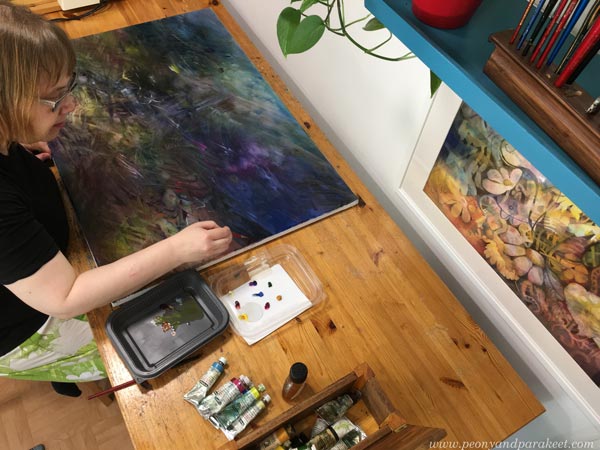
I don’t usually post about a piece that I haven’t finished yet. It’s like presenting an uneducated child that doesn’t quite know how to behave. But the more perfectly my art has aligned with my personality, the more I have started to embrace imperfection. My art will always be imperfect because I am imperfect. Life is imperfect.
Rational or Mystical?
My education in software engineering has shaped my beliefs about life for tens of years. But recently, I have had experiences that feel less scientific and more mystical.

My paintings seem to know how they want to grow, and my ego disappears.
One Mystical Morning
One morning, when I was walking the dog, I saw a miraculous view. It was meant to be just an experiment. I asked myself to look at nature like I would look at a painting in progress. And suddenly, I saw everything in a new order – not organized by a hierarchy or by their aesthetic value. Gravel, weed, grass, dandelions, trees – all were equal and formed one mysterious mesh.
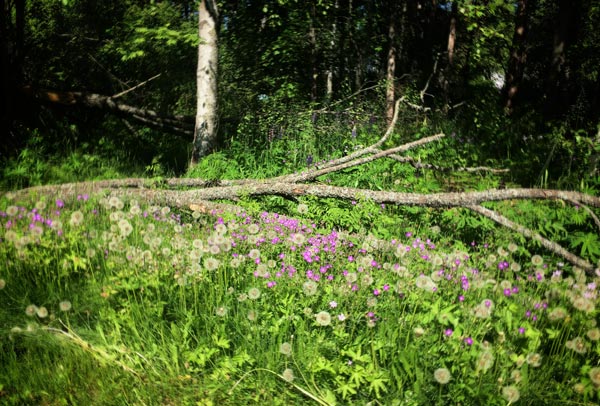
I was part of that mesh too. Not any more valuable than a crooked stem of a dandelion, but still tremendously happy and free.
Every Stroke is a Weed – For How Long Can It Grow?
We art instructors talk often about visual hierarchy – there’s a lot of that in my classes too! The image needs a focal point, and there needs to be a visual flow in a composition. Otherwise, the image looks stiff and the viewer is left puzzled. But the more I have painted, the more I have postponed all that visual organization. That’s why you see me working on the table mostly, focusing on the details.

When the painting is in progress, it grows all kinds of weeds, and it’s ok. Then, when I am close to an end, I will put the painting on the easel and improve the visual hierarchy and flow.
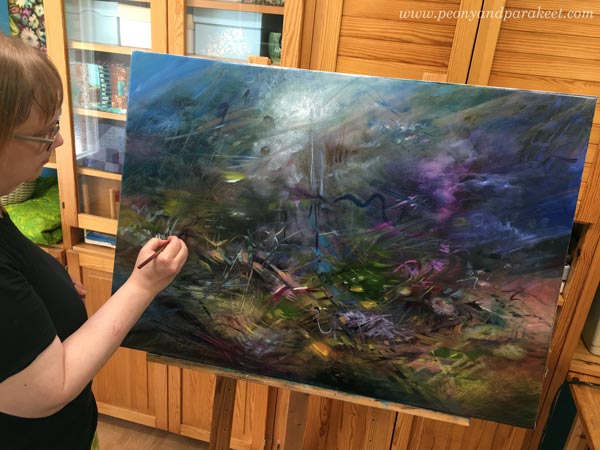
So, I let the child play freely first before teaching it to greet, bend the knees a bit, and make the viewer feel welcome. Before the last part, I can just enjoy the mesh and let the artist be one with the child.
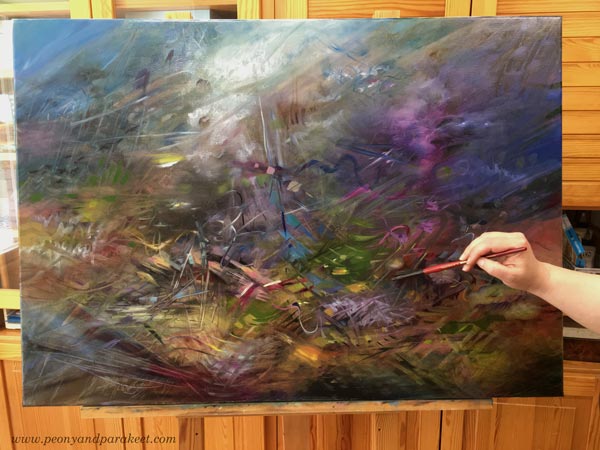
What do you think? Does this make sense to you? Have you had mystical experiences?
Monet in the Box – Creativity and Shame
This week, I show my latest finished painting and talk about Monet and the hall of fame – no! – the box of shame!

Last week, I participated in an online event organized by the Finnish Illustration Association. One of the speakers was Eeva Kolu, who talked about maintaining balance in life, not letting work take over all of it. She referred to a book that she had written which is unfortunately available only in Finnish. It’s called “Korkeintaan vähän väsynyt” (free translation: A Little Tired At Most)
I have been listening to the book on daily walks, and even if I am not finished yet, I already like the inner dialog that it raises. It makes me stop to ponder, sometimes agree, other times disagree. It’s not only pleasant, and yet, it’s definitely worth reading. One of the things Eeva Kolu brings up is shame. She says that shame defines the size of the box where we live. The box can become so small there’s not much room for life.
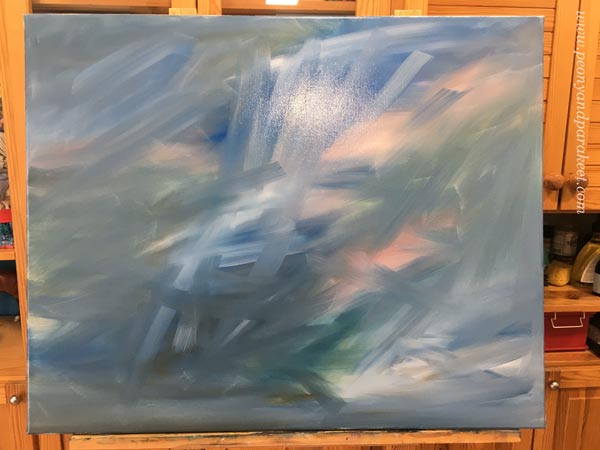
Eeva Kolu made me think about all the things I am shame of. Surprisingly, one of them is central to my art.
My Relationship With Old Art
When I was in my twenties and thirties, all I wanted to see was contemporary abstract art. In museums, I rushed through the old paintings because representational and traditional art was for mediocre people, and I didn’t want to be one of them. I felt shame about my uneducated family and the lack of abstract thinking in the surroundings where I came from. I had a new life with higher education, and my love for mathematics was well aligned with geometric shapes and lines.
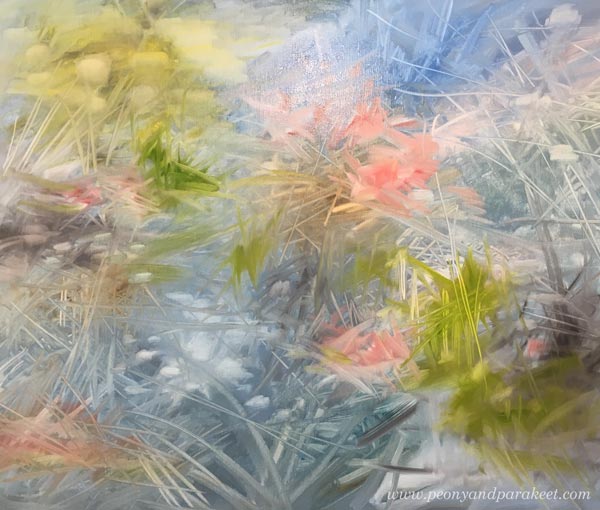
But age has made me understand more about my background and art as well. I have begun to love old art, and still, it’s something that causes me shame as well.
“Waterlilies,” my husband said when he saw this painting.
It made my box shrink. My intention was not to do any Monet. I just painted the dreamy blue that needed to come out, not make any imitation of anything.
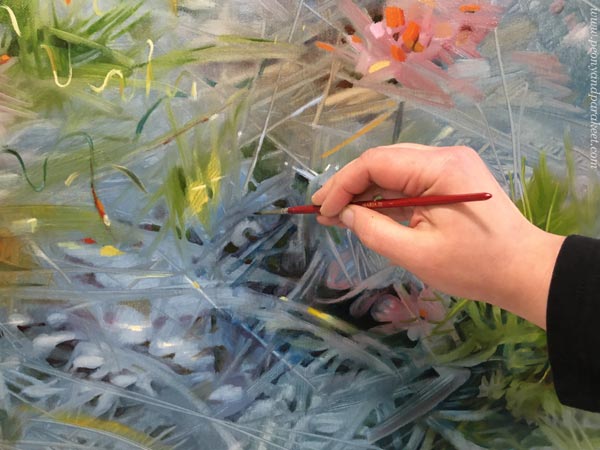
I Kind of Hate Monet’s Waterlilies
I have seen them in National Gallery in London. They are captivating. People love them.
But instead of making what people easily love, I would like to be an artist who sees to the future. Who builds paintings that are like complex machines. I should be a Leonardo of this age, imagining something technical that engineers will skillfully implement someday.
But my art has a mind of its own. No, a mind of mine. Or would I dare to say: a mind of my shame. I am stuck to the past, so I paint the past. I reach the worlds that feel excitingly unknown first but turn out familiar once the painting is finished. I end up recreating instead of inventing. That’s my shame.
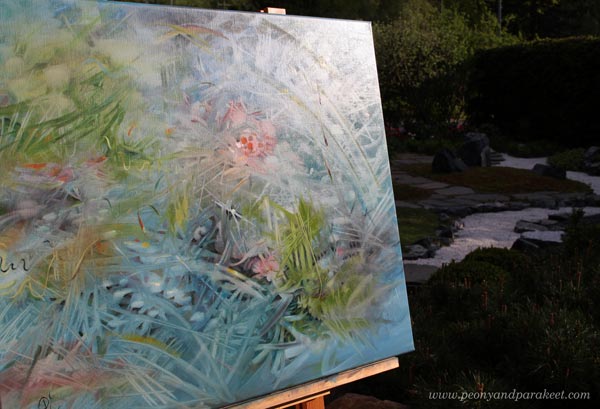
In my classes and in this blog, I talk about old art now and then. But compared to the amount I think about stiff renaissance portraits, romantic baroque sceneries, frilly victorian dresses, cubistic still-lives, and all the masterpieces from the 15th to 20th century, it’s very little.
“My Readers Want Their Art to Be Current”
That’s what I say to myself often. The readers – you – don’t like old art so I try not to write about it. And still, the expected goal to be current seems ridiculous sometimes. There’s a bridge between current and old, and it’s very difficult to be current without knowing what’s not.
That bridge – or should I call it a long historical timeline – is the place where my creativity naturally lies. My shame is also my utmost love. When I paint, I don’t think about Rubens, Monet, Picasso, or Kandinsky. When you love something deeply, with the skills, it comes out naturally.

“Everyone discusses my art and pretends to understand, as if it were necessary to understand, when it is simply necessary to love.”
Claude Monet
Monet’s attitude seems very unintellectual. And yet, if you think about what you create and have created, can you relate? That sometimes it’s necessary to omit the feeling of intellectual understanding, bypass the shame, and simply love – so, widen the box instead of trying to get out of it?
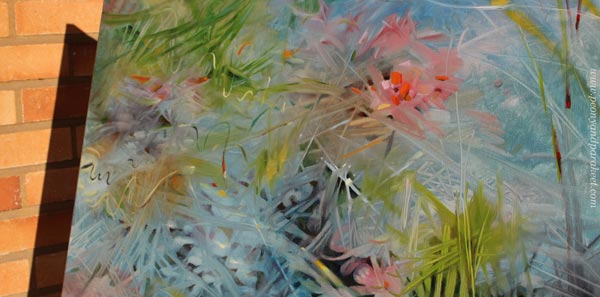
Thumbs up or down for talking about art history and old masters? Share your thoughts in the comments!
P.S. Claude Monet is “a guest teacher” in the class Floral Freedom!
Free Like a Bird – Creating Free from Expectations
This week, I write about my personality type based on Thomas Erikson’s book Surrounded by Idiots and how to paint free from expectations.
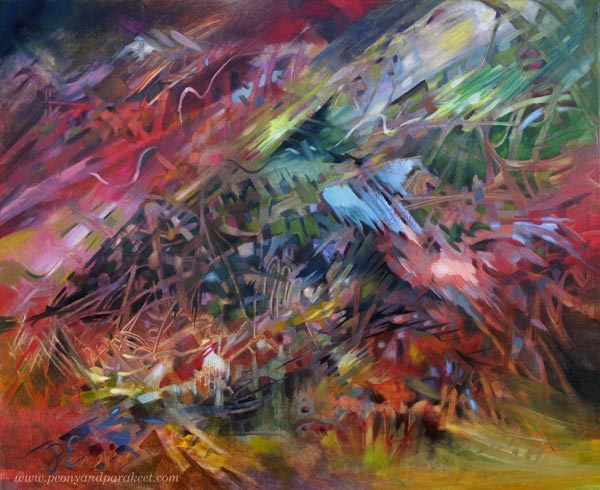
Here’s my newest painting. When finishing it, I became surprised gladly when “Blackbird” got a little sister “Finch.” Here’s Blackbird again:
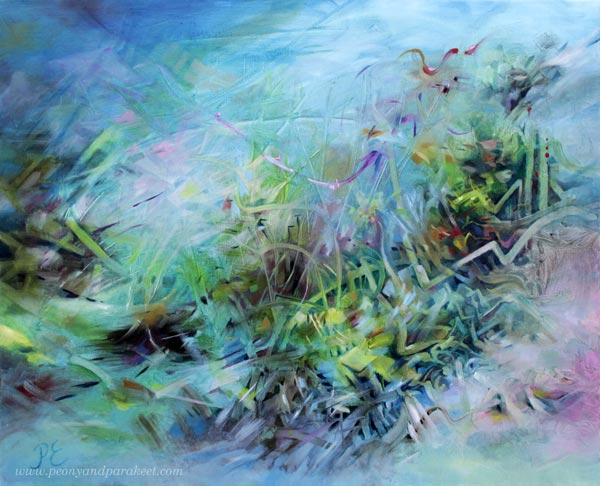
Book: Surrounded by Idiots – The Four Types of Human Behaviour
All my life, I have had strong opinions about how and what I should paint. And yes, these opinions have not been something like “powerful dreams” but more like pushy commands. I didn’t even realize how pushy they have been until I read Thomas Erikson’s book “Surrounded by Idiots.” It made me think about my personality from a new perspective.
Even if the idea of the book – dividing personalities into four categories and naming them by colors – could be taken as nonsense, after reading it, I can’t help thinking about how “red” I am. An ambitious fact-oriented person who has pushed herself to the utmost limit with this art-making obsession.
If you are “yellow,” you probably think that I should either have fun or move on. “Greens” might recommend taking a rest and stopping working too hard. And “Blues” claim that the book is not scientifically proved and there’s no reason to quit.
But I have discovered a new solution. It’s been a joy to use my red energy only to make sure that I keep painting. When I open the tubes, my redness is gone. I am open to painting anything. Every ugly start feels like an invitation to the jungle: Let’s see what’s going on in the inner world.
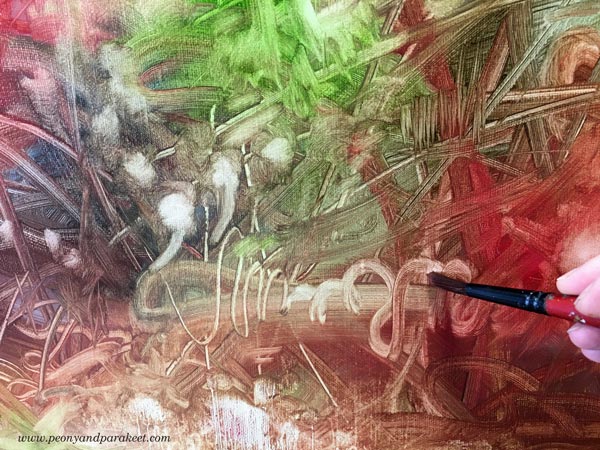
Breaking the Glass – Growing Compassion Towards Inanimate Things
In the class Floral Freedom, you dive deep into Wassily Kandinsky’s ideas about abstract art. Among other things, he talks about breaking the glass – stopping being the observer and starting to be the one that experiences things. Now when I have been pushing myself for almost seven years, the glass has become thin. I feel joy about how easily it breaks right after squeezing the paint on the palette.
For a red person, it has been difficult to break through. I have been giving orders and tightened the control from time to time. But now, the only goal for the spring is to paint all the canvases that I purchased earlier this year. Not questioning what I paint, but just do it.
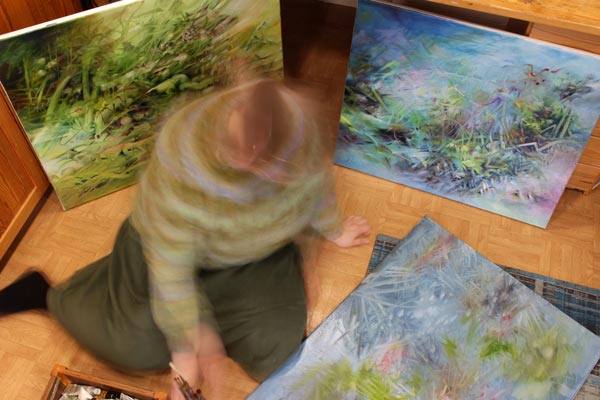
“Do it!” the red in me commands matter-of-factly and then leaves me working. After breaking the glass, I arrive at a lobby that’s filled with all kinds of stuff. For example, there are tulips that my husband removed from the bench where they were not supposed to grow.
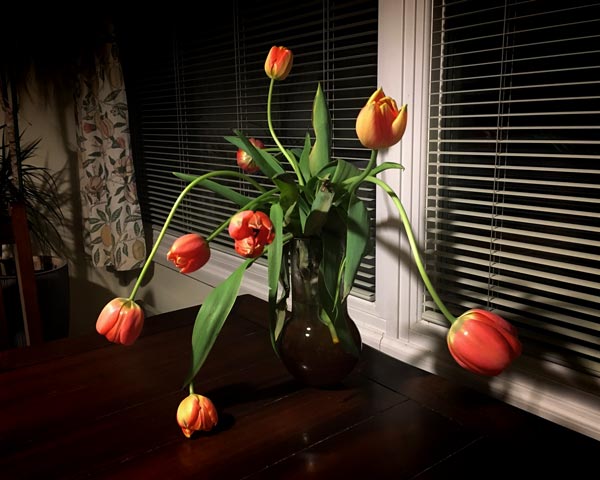
They twisted and turned in the vase, like wild animals in a cage, trying to break free. And when they withered, they became angry and devastated beasts, desperate to continue their lives. They didn’t want to face the fact that they wouldn’t reproduce like they were born to do.
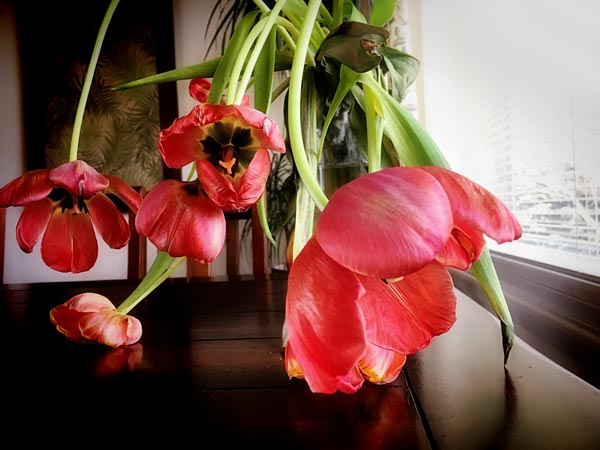
When painting, we can see similar things or just glide on the glass and bypass them. Shapes that don’t get the place in the spotlight. Lines that disappear before they reach high enough.
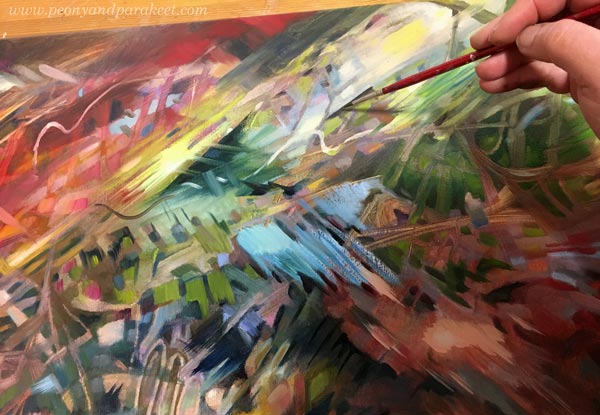
But if we put our mind into noticing them, we can make these inanimate splotches of paint breath and fly, even save some ugly spots. Not because we would hasten and thus compromise the quality, but because we feel sudden compassion towards their character.

Then a picture is not forced but appears naturally. However, the result is not static or exact like the observer would want. Instead, it describes the inner experience of being.
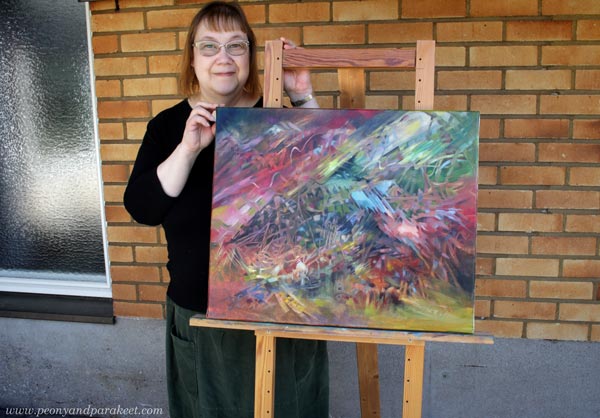
The Experience of Being a Finch
In this painting, the being is a little bird, facing danger, trying to take care of its nest, flying and falling, still living the summer of her life.
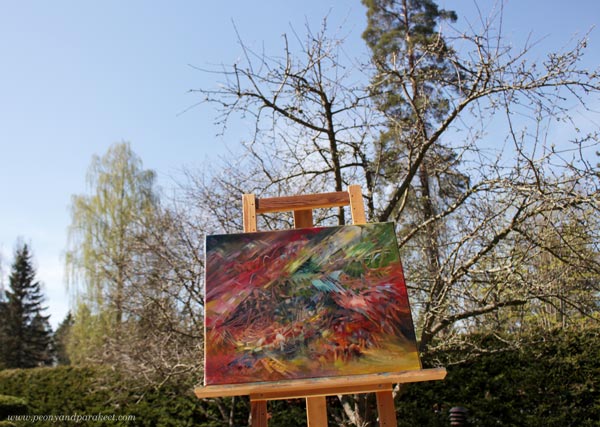
Have you read Thomas Erikson’s book Surrounded by Idiots? Do you see a connection between your personality and art-making?
3 Tips for Bringing More Life into Your Art
This week, we look for what’s natural and lively in a bit different way than usual. I share three tips for bringing more life into your art.
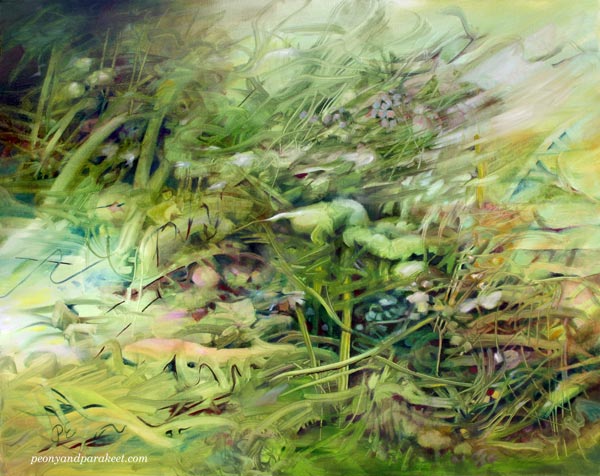
I just finished this green painting. It’s called “Muuttumaton” in Finnish, but this time, the translation “Unchanging” fits it better because the English word has a more active tone.
This painting was in progress in the video that I shared a couple of weeks ago.
Here’s the video again so that you can see me working with this in practice and compare the middle and the end!
So, that was the video, but in this post, I want to give you ideas on how you could bring more life into art.
These ideas are not technical because I think that my classes are better for learning the techniques, but more about changing the way you get inspired and observe what first appears on paper or canvas.
Tip #1 – Let Weeds be Weeds
In my painting, the main character and the focal point is a blooming weed. It appeared on the canvas right away and reminded me of Fernando Pessoa‘s poem that talks about a crop bending with the wind and then straightening once the wind stops. This kind of natural resilience that weeds also have is inspiring. In art, we usually make weeds look more like a flower. But could we loosen up and bring more life by letting the weeds be weeds?
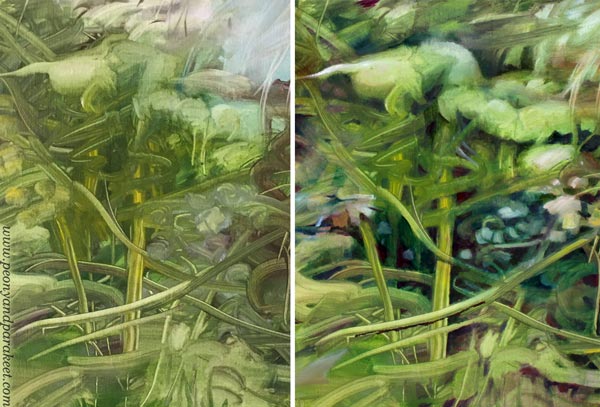
So, I just made the big plant look a bit more defined and let it be the star of the show.
Tip #2 – Try to Ignore Color
Even if I took pictures of the painting in our garden, I have been more inspired by the untamed side of nature lately.
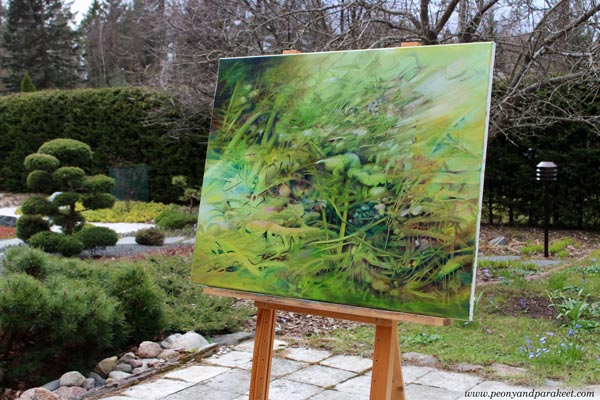
With my beagle Stella, I have been exploring banks and woods that look ugly but are full of layers. For Stella, layers of smells, and for me, layers of shapes and textures. I have tried not to seek the most beautiful spring flower, but develop my eye to notice other than colorful things.

What looks ugly first can be beautifully free.

Subtle changes in color can make the painting look more lively than if you throw in a bunch of strong colors.
Tip #3 – Embrace Destruction
When bringing life into art, it’s not that we have to start with life. We can look at broken and deserted things like fallen or chopped branches. They can then have another life in our art. Imagine branches falling further down and breaking the cover between the outer and inner world. What kind of life could you give them there?
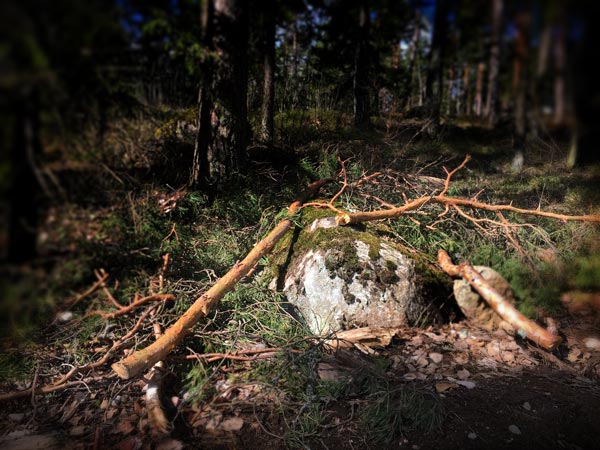
Admire how the grass grows, but also, how it withers!

When we create, we can start with destruction and then use colors to make all the ugliness bloom. This way, we build a bridge between the garden and the wilderness – between the traditional beauty and nature’s aesthetics.
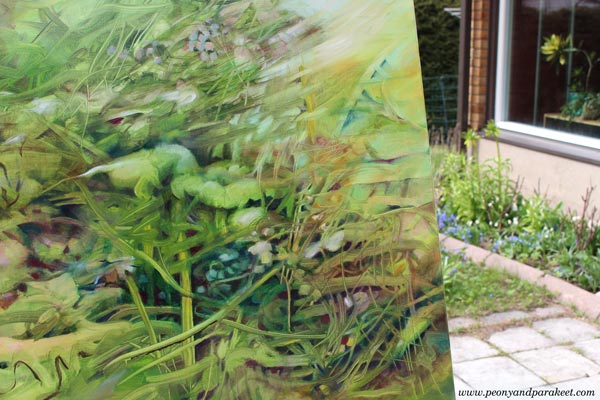
I don’t use references for my half-abstract paintings like this one. But I believe that things that we see and appreciate find their way to our art in one way or another.
So when you want to bring life to your art,
look for life as it is in the wilderness, not only as it is in your garden.
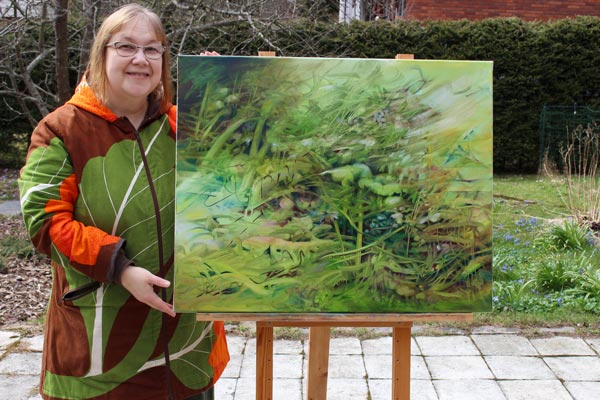
When looking at this painting, I want to be like that weed, stand tall where I happened to fall. I want to believe there’s something unchanging in this ever-changing life that keeps us creating. I hope we can be Pessoa’s crop that straightens right away when it gets the chance!